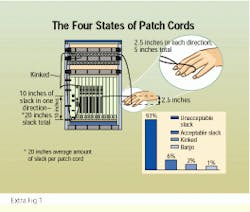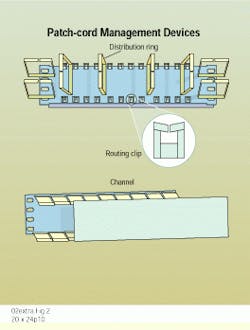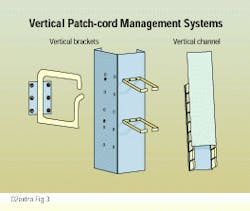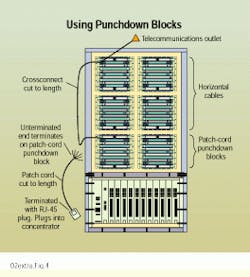In glossy brochures and trade show displays, patch panels are always tidy and well-dressed. In the telecommunications closet, however, the reality more closely resembles a "rat`s nest" -- a term that is frequently used to describe this area.
Dennis Mazaris, PerfectSite
As the demand for high-speed enterprise networks has increased, so has the need for high-density modular patch panels and the patch cords that populate them. And with the limited space available in wiring closets and equipment rooms, the need for patch-cord management systems is greater still.
While cabling standards such as tia/eia-568a and the international standard iso/iec-11801 have addressed many cabling issues, they pay little attention to the most disorganized part of any cabling infrastructure: the patch-cord management system. Often described by such terms as "rat`s nest," "spaghetti," and "jungle," the working patch panel is both an eyesore to visitors and an invitation to networking problems for installers and maintainers.
To examine the state of patch-cord management systems, PerfectSite (Sterling, VA), a structured cabling consulting firm, conducted a study of 20 sites in the Washington, DC, area during eight months in 1996. To qualify for the study, a site had to have at least 100 unshielded twisted-pair (UTP) or screened twisted-pair (ScTP) modular patch cords attached to a single or adjacent racks or cabinets. The sites included government installations (50%), systems integrators (15%), law firms (15%), accounting firms (10%), and commercial establishments (10%).
During the study, the PerfectSite inspection team examined 473 patch panels in 87 wiring closets. In all, 16,242 patch cords were inspected, along with 723 horizontal patch-cord managers and 1066 vertical managers. Hook-and-loop (or Velcro) and tie-wrap devices, used in 41 of the closets, were classified as supplemental to the horizontal and vertical systems with which they were used.
The study consisted of random selection and examination of 1624 patch cords, 10% of the total, for a statistical accuracy level of ?3%.
The examinations conducted by the inspection team showed that the patch cords--which, for the purpose of the study, were defined as flexible cables with modular plugs on each end that are used to establish connections between patch panels and equipment--could be divided into four categories, as follows:
Acceptable slack--The study applied the "three-finger" guideline to determine acceptable slack in the patch cord. That is, the inspector placed three fingers at the point where the patch cord entered the horizontal manager and was routed to the data-equipment port. Acceptable slack of 5 inches or less resulted when the cord could be looped around three fingers at that point. Of the patch cords surveyed, 6% were found to have acceptable slack.
Unacceptable slack--Any length of patch cord over the "three-finger" limit was deemed unacceptable. The study found that 93% of all patch cords examined were too long. The average overage per patch cord was 20 inches. Although this may not seem like much, consider that, multiplied by 187, the average number of patch cords per closet, a total of 312 feet of patch cord, longer than a football field, sits unused in each telecommunications closet. This accumulated slack hangs in disarray, affecting manageability, aesthetics, bend radius, and bend-radius stability.
Kinked--This condition occurred when a patch cord was collapsed on itself, bent 180o, virtually without bend radius. In every case, kinked patch cords, accounting for 2% of the total examined, also had excessive slack.
Banjo--This condition is found between the equipment port and the horizontal patch-panel port when a patch cord that is too short is installed without benefit of vertical management. One percent of the patch cords examined had this problem.
"The number-one problem in patch-cord management today is excessive slack," says Herbert Mendelsohn, a retired communication specialist formerly with the U. S. Department of Agriculture and now an industry advisor. The problem occurs because patch cords are manufactured in one-foot increments rather than to length. Moreover, when companies stock many different lengths in inventory, they commonly use an overly long cable when the correct length is out of stock. Also, when in doubt, cable-plant managers typically order cords that are too long, since cables that are too short are virtually useless.
"Another problem," adds Mendelsohn, "is something I call `the entangling effect.` This phenomenon occurs when someone relocates a patch cord and, instead of pulling it out completely and starting over, he or she simply unplugs the patch cord and sticks it into the new port atop other cables."
Other findings
The PerfectSite study also shed light on a number of other patch-cord issues. For example, should you rely on manufactured patch cords or make your own? Only 3 of the 20 sites surveyed made their own, while 85% depended on manufactured patch cords. Manufactured cords were preferred because they were thought to be more reliable, and even those sites that made their own were discontinuing the practice because of the high data rates the cords were expected to carry, the lack of experienced labor to make them, and the unmet need for quality assurance. Ironically, hand-made cords generally had the same amount of slack as manufactured patch cords. At the time of first use they may have been cut to exact length, but over time these cords were moved around and so the advantage of custom fit was lost.
Another area of concern has been bend radius. Many industry practitioners mistakenly apply Section 10.6.3.2 of tia/eia-568a to patch cables. The standard calls for a bend radius of "not less than four times the cable diameter for horizontal [UTP] cable," and by extension the same limit is applied to ScTP cable in Section 10.2.1. However, this restriction only applies to the termination of horizontal cable runs at the back of the patch panel, and not to the patch cords found at the front.
In the international standard, the patch cord is included in the bend-radius requirement set forth in Section 9.1.6--four times the diameter of the outer cable. However, the requirement is marked "f.f.s." (for further study), which means that it is not required for conformance to the iso/iec 11801 standard, since adequate data has not been presented to the scientific community. Only 7% of the patch cords surveyed by PerfectSite were four times the outer-cable diameter.
Another issue in this area is bend-radius stability. Unlike the situation in horizontal cabling runs, where the cable is stable once pulled, patch cords may be moved constantly. A patch cord measured for study on one day may have a different bend radius, or even be kinked, the next day. This situation obviously does not apply to the back of the patch panel, where horizontal cabling can be secured from movement.
Patch-cord management
Horizontal and vertical patch-cord management systems also affect bend radius. For example, the study found three types of horizontal patch-cord management in use, each of which affected bend radius differently. Distribution rings were the most common way of directing the patch cords from the patch panel to the vertical management system. Routing clips were used at some sites. Smaller than distribution rings, they could be more densely populated on the horizontal manager, allowing a straighter patch. The third type of horizontal manager was the channel or duct.
The distance between the end of the distribution ring, routing clip, or channel and the patch panel was an important factor affecting bend radius. The shallow depth of the distribution rings, for instance, led to smaller patch-cord bend radius. The shallowest measurement was found, however, on cords directed into routing clips; here depth was typically 0.5 to 1.25 inches.
If a strain relief or boot was present, the bend might be sharpened even more when directing the patch cord into, say, a 1-inch routing clip. Patch panels from some manufacturers also extended 0.5-inch out from their horizontal plane, further reducing the distance between the distribution ring and patch panel.
Vertical patch-cord management usually consisted of either brackets or channels. The brackets came in many sizes and shapes, but were often comparable in size to their horizontal counterparts, even though required to handle many more cables. Channels, because they are more restrictive, showed by far the most problems when it came to bend radius and cable slack. (Cabinets also exhibited more problems than racks with bracket managers for the same reason: Their restrictiveness lowered bend radius and made slack more difficult to deal with.)
Vertical management systems were clearly more problematic than horizontal ones. The PerfectSite study showed that many vertical management systems were simply incapable of accommodating the amount of cable slack accumulated in the patching system.
However, bend-radius problems were not as prevalent as those encountered in vertical management systems, although 32 cases of kinking were recorded. This was because of the great accumulation of slack that had built up over time in vertical systems, along with the entangling effect described above. Also, vertical systems were more likely to have patch cords tightly crammed into them, creating a situation best described as "overfilling."
Supplemental support from hook-and-loop or cable-tie systems has improved substantially over the last two years, but none of the sites studied used these methods as their sole provider of support. In fact, Velcro strips or plastic tie wraps were more often used in desperation just to keep patch cords out of the way. In each case where such devices were employed, it took longer to identify a patch cord because it was first necessary to remove the Velcro strip or tie wrap.
Some possible remedies
The PerfectSite study indicates that high-density patching using conventional patch cords and panels is inadequate for the demands of a commercial environment, even though the sites surveyed had ample horizontal and vertical patch-cord management systems.
In almost every case, these installations violated the spirit, if not the letter, of applicable national and international standards. For example, Section 8.4 of tia/eia-568a states: "Appropriate cable routing and dressing fixtures should be used for effective organization and management of the different types of cables in telecommunications closets." Iso-iec-11801, in Section 9.1.6, provides similar guidance: "The manner and care with which the cabling is implemented are significant factors in performance and ease of administration of installed cabling systems."
The problems with patch-cord management today--the accumulation of excessive slack in standard-length manufactured cords and the entangling effect that turns them into "spaghetti" over time--will not be solved by handmade patch cords. As we have seen, such cords may eventually experience the same problems as manufactured items, and they suffer the additional problem of uncertain, inconsistent, or degraded performance.
This has led patch-cord users to cast about for other solutions to these problems. One alternative that some firms are using is to terminate one end of the patch cord on a punchdown block, while the other end is terminated in the traditional way, with a connector that fits into the equipment (concentrator). The patch cord punchdown block connects to the horizontal cabling system through a crossconnect field. Creating such a crossconnect field permits you to cut your patch cords to the proper length for each connection.
However, such a solution may be in violation of tia/eia-568a if the manufacturer`s punchdown block does not accept stranded cable. The cabling standard currently calls for using stranded patch cords in this application, although solid-wire patch cords are being examined for possible inclusion in an addendum to the standard.
What is certain is that the patch-cord problem is real, and it is important. According to Datapro Information Services Group, "Physical management problems account for about 50% of network problems and downtime." At least some, and perhaps much, of this downtime results from problems with patch cords.
Why don`t such problems get addressed? A recent survey suggests an answer to this question. Several years ago, Computerworld magazine surveyed 361 information- systems professionals and generated a list of the Top 10 Worst Jobs in Information Systems. Second on that list was troubleshooting cabling. "It is an especially frustrating and time-consuming task," the article said.
However, surveys alone are not enough to define the problem. One of us at PerfectSite served as an expert witness in a civil case not long ago. The litigation revolved around a patient with a history of heart trouble who died in a hospital`s cardiac care unit. The patient`s bedside heart monitor registered the problem, but the audible signal failed, and the redundancy system connected to the nurse`s station also failed. It was found that one of the problems leading to the failure of the hospital`s monitoring and alarm system was an incorrect patch in the wiring to the nurse`s station. The technician who maintained the cabling system said that the incorrect patch was made because he couldn`t tell what he was doing at the patch panel because of the "mess of all those cables everywhere."
In the last decade, the cabling industry has come a long way. Evolving from a conglomeration of proprietary voice- and data-system makers, it is now represented by national standards bodies, industry organizations, and other groups dedicated to its growth and maintenance. One problem that these groups should begin to take seriously is the role of patch cords in horizontal cabling systems--and, by extension, in the integrity of the entire network. Otherwise, those "rat`s nests" will continue to plague installers and maintainers of premises and campuswide cabling systems.
Only 6% of the patch cords examined in the PerfectSite study passed the "three-finger" test for acceptable slack. The average amount of extra slack per patch cord determined by the study was 20 inches, which amounted to more than 100 yards of extra slack per wiring closet.
The most common devices used for routing patch cords horizontally at the patch panel are distribution rings, routing clips and channels.
In vertical routing of patch cords, brackets and channels are most commonly used.
One way to keep patch cords from getting messy is to terminate one end to a punchdown block, while keeping a modular connector on the other end for use with equipment (concentrator).
Why do those model patch Panels at TRade Shows Look So Good
A number of respondents to the PerfectSite study commented on the difference between model patch panels and equipment racks displayed by manufacturers at trade shows and the situation in their own business establishments. In the trade-show models, patch cords are always carefully dressed and routed, and never show the slack and entanglement typical of real situations.
In talking to manufacturers, PerfectSite determined that the
secret of these displays is cut-to-length patch cords. When asked if the patch cords were left attached to their models during shipping from show to show, one manufacturer laughingly responded, OIt would take us weeks to put them back where they belong if we unplugged them.O
Another interesting note: On completion of its study, PerfectSite contacted 10 leading manufacturers of patch-cord management systems to find out what type of documentation was available to users of their equipment. Nine of the ten responded that they provided no documentation, and the tenth sent minimal instructions. The reason given by manufacturers for this dearth of information is that there are too many variables involved in designing patch panels and patch-cord management systems for manufacturers to address in installation instructions. And yet, all 10 manufacturers, when questioned, demonstrated a knowledge of the problems involved with high-density patching. They simply accepted these problems as Othe nature of the beast.O
Dennis Mazaris, registered communications distribution designer (rcdd), is president of PerfectSite (Sterling, VA), a cabling consultancy devoted to needs analysis and design, third-party verification, performance monitoring, mediation, bid-package evaluation, market analysis, and training.



